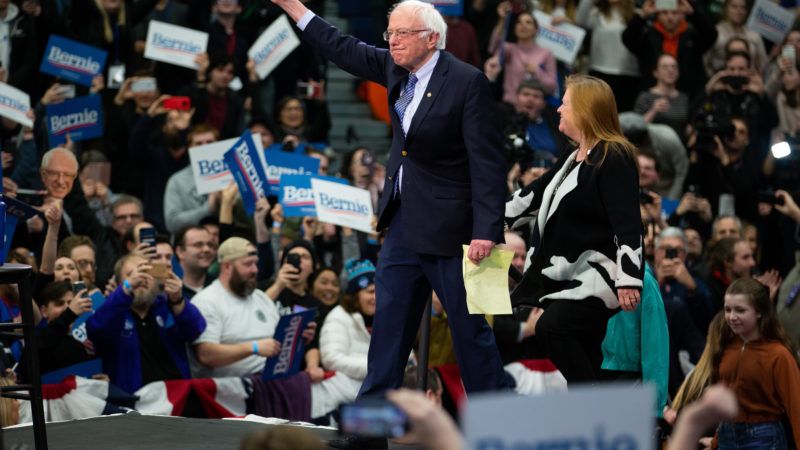Is Bernie Sanders the Democratic Party's Donald Trump?
Like Trump before him, Sanders is using establishment disunity to mount an insurgent campaign.

Last night, Sen. Bernie Sanders (I–Vt.) won the New Hampshire primary. Along with his strong showing at last week's Iowa caucuses, his devoted base, and his position atop national polls, that makes Sanders the front-runner for the Democratic presidential nomination. In one way, this is a strange situation: A self-declared democratic socialist and longtime critic of the Democratic Party is now the leading contender for that same party's nomination. But in another way, it feels awfully familiar. In Sanders' rise, there are clear echoes of Donald Trump's tumultuous path to power in the GOP.
Start with Sanders' campaign strategy. In a 2018 profile for New York magazine, a former Sanders adviser explained how the candidate hoped to win: "Facing what's likely to be a historically large field, he's been told, Sanders could start with his most loyal supporters from last time and go for a tight plurality victory in Iowa's caucuses, followed by a slightly bigger one in New Hampshire's primary. From there, advisers hope, his numbers could grow as the field dwindles." In broad strokes, that is almost exactly what has happened so far. And, as Sanders' advisers admitted in the piece, it is much the same approach that Trump used in 2016.
Like Trump, Sanders has used the unusually large Democratic field to his advantage, drawing on a big base of support while other candidates, particularly those running as moderates, vie to consolidate support and become his leading rival. As Reason's Matt Welch has often noted, the combined polling totals for the Democratic "moderate" candidates like former Vice President Joe Biden, Sen. Amy Klobuchar (D–Minn.) and South Bend, Indiana, Mayor Pete Buttigieg have typically run 10 points or so ahead of the totals for progressive candidates like Sanders and Sen. Elizabeth Warren (D–Mass.). But the high floor of support for Sanders, the collapse of the Warren campaign, and the failure of the center to rally around Sanders alternatives have put Sanders at the top of the heap.
Sanders, in other words, is using the party establishment's disunity as a vehicle for mounting an insurgent campaign. In an era in which Democratic leadership can't seem to decide who—or what—to support, Sanders is stepping in and offering to fill the void by appealing to a vocal part of the Democratic coalition that has often felt left out of the party's mainstream.
For Trump, that meant rallying older, working-class populists angry with the nation's political and cultural elite. For Sanders, it means activating a different sort of populist coalition, one that is younger and more diverse, but similarly distrustful of elite power as it currently exists. Their coalitions are not the same, but the messages both candidates use to reach those coalitions have more than a little overlap: The people in power aren't looking out for your interests or your values; as president, I'll punish them—and help you.
There are other similarities between the candidates as well: Their relatively advanced ages, their fondness for foreign authoritarians, their lack of interest in the difficult particulars of federal budgeting—and, perhaps most of all, their desire to break and then remake America's major political parties in their own image.
So much as Trump represented a substantial departure from traditional GOP power centers, Sanders' ascent represents a near-total break from the Democratic Party establishment as we have known it for the last 30 years. Just as Trump trounced GOP scion Jeb Bush, who represented continuity with the Republican Party as it had been known for decades, Sanders is trouncing Biden, the primary's incarnation of Democratic Party power, stretching back to the Obamas, the Clintons, and even before. Bush and Biden served as avatars of their party establishments; the victories of Trump and Sanders (so far) show just how weak those parties have become.
One might argue that this is a good thing, insofar as it helps expose the insufficiency of the two-party duopoly, and the real and longstanding ways that binary system has failed to serve the interests of many, perhaps most, voters who don't fully align with one or the other.
Or one might argue, like Jonathan Rauch and Ray La Raja, that this represents a failure of responsibility on the parties, who have historically vetted candidates, that leads to candidates who are not only unqualified but dangerous. Indeed, candidates nominated through this process are arguably unrepresentative, in that, at least at first, they represent pluralities rather than majorities within their own parties.
I think there is some truth to both views: The old model of two-party politics, with its indifference to individual political idiosyncrasies, left out many people and worldviews. And its standard-bearers, in both parties, presided over large and ongoing failures of policy and governance. Those failures are an important driver of the Sanders-Trump backlash we're witnessing now.
Yet it's far from clear that the emerging model, with its bias toward fringe populism, is an improvement; indeed, it may be worse. For it looks increasingly plausible that it will leave us with a presidential election that offers a choice between a right-leaning authoritarian populist on one hand and a democratic socialist who has too often given a pass to foreign dictators whose politics align with his own. That's not much of a choice.
And in many ways, the lack of choice was always the problem. Sanders and Trump may have revealed the weaknesses of the two-party system and hijacked it for their own ends. But they haven't defeated it.
Show Comments (161)